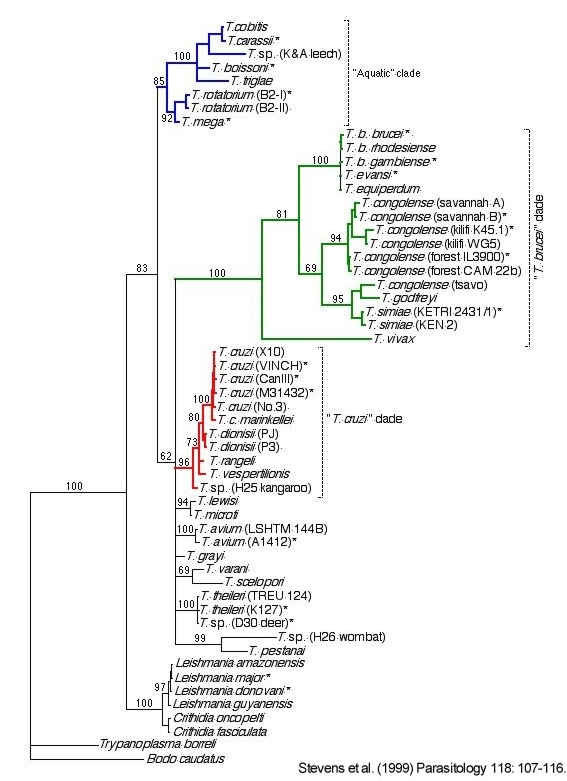You are here
Trypanosomes
The evolutionary genetics of pathogenic trypanosomes
This work is a long-running collaborative programme with Prof Wendy Gibson (Bristol) and Dr Patrick Hamilton (Exeter) on the evolutionary genetics of pathogenic trypanosomes (with special reference to the human pathogens, Trypanosoma brucei and Trypanosoma cruzi). Research utilises 'traditional' sequence data (e.g. 18S ssu rRNA, GAPDH, miniexon) and genomic analysis.
Phylogenetic analysis of these data has allowed a re-evaluation of the evolutionary relationships of these important disease agents (see Figure) and, for the first time, has provided evidence of a divergent late-Cretaceous origins for the two forms of human-infective trypansomes. More recent research has extened these findings and has highlighted the potential role of bats in the evolutionary spread of human infective trypanosomes; the so called 'bat-seeding hypothesis'. See:
Hamilton, P. B., Teixeira, M.M.G. and Stevens, J.R. (2012) The evolution of Trypanosoma cruzi – the ‘bat seeding’ hypothesis. Trends in Parasitology, 28 (4): 136–141. [View PDF]
Key publications
Stevens, J. & Gibson, W. (1998) The evolution of Salivarian trypanosomes. Mem. Inst. Oswalso Cruz 94: 225-228. [View PDF]
Stevens, J.R., Noyes, H.A., Schofield, C.J. & Gibson, W. (2001) The Molecular Evolution of Trypanosomatidae. Advances in Parasitology 48: 1-56. [PDF (11.5 Mb) available on request]
Stevens, J. & Rambaut, A. (2001) Evolutionary rate differences in trypanosomes. Infection, Genetics and Evolution 1: 143-150. [View PDF]
Hamilton, P.B., J.R. Stevens, M.W. Gaunt, J. Gidley & W.C. Gibson (2004) Trypanosomes are monophyletic: evidence from genes for glyceraldehyde phosphate dehydrogenase and small subunit ribosomal RNA. International Journal for Parasitology, 34: 1393-1404. [PDF available on request]
Simpson, A.G.B., Stevens, J.R. and Lukes, J. (2006) The evolution and diversity of kinetoplastid flagellates. Trends in Parasitology, 22 (4): 168-174. [PDF available on request]
Hamilton, P.B., Gibson, W.C. and Stevens, J.R. (2007) Patterns of co-evolution between trypanosomes and their hosts deduced from ribosomal RNA and protein-coding gene phylogenies. Molecular Phylogenetics and Evolution, 44 (1): 15-25. [PDF available on request]
Leonard, G., Soanes, D.M. and Stevens J.R. (2011) Resolving the question of trypanosome monophyly: A comparative genomics approach using whole genome data sets with low taxon sampling. Infection, Genetics and Evolution, 11: 955–959. [View PDF]
Hamilton, P.B. Cruickshank, C., Stevens, J.R. Teixeira, M.M.G. and Mathews, F. (2012) Parasites reveal movement of bats between New and Old Worlds. Molecular Phylogenetics and Evolution, 63: 521–526. [View PDF]
Stevens J.R. (2014) Free-living bodonids and derived parasitic trypanosomatids: but what lies in between? Trends in Parasitology (in press) [View PDF]
Hutchinson, R. and Stevens, J. R. (2018) Barcoding in trypanosomes. Parasitology, 145: 563–573.
Click here to view additional publications from 1989–present.
- 26641 reads
The University of Exeter, The Queen's Drive, Exeter, Devon, UK EX4 4QJ
Copyright and Disclaimer


